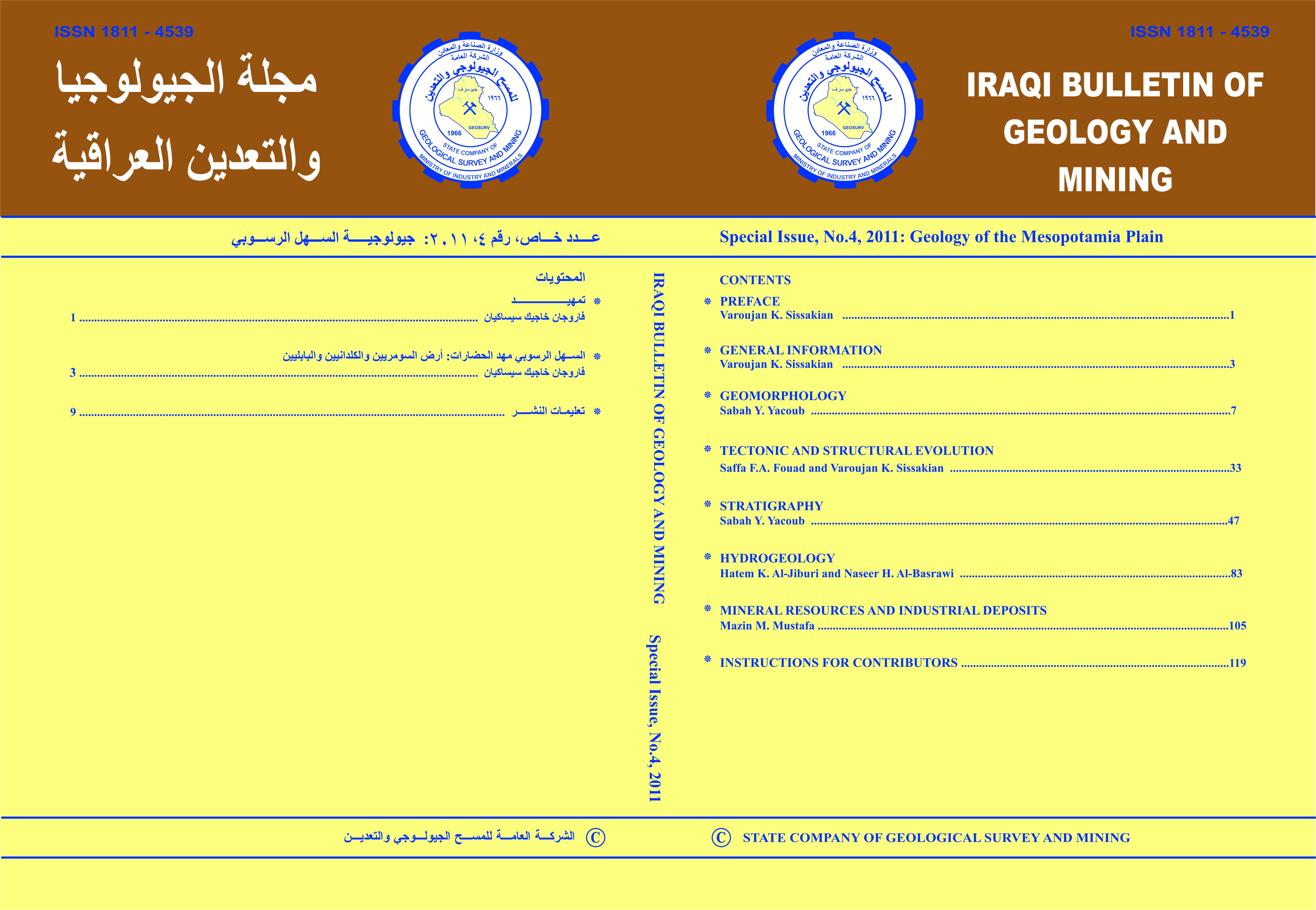Abstract
The present study is a review of the geomorphology of the Mesopotamia Plain. It depends on the data obtained from the regional geological survey project of the plain, which has been carried out during the years 1977 through 1981 by GEOSURV's geological staff.
The Mesopotamia Plain is vast lowland, which has clearly defined physiographic boundaries with the Low Folded Zone, in the northern and eastern sides and the Western Desert and Al-Jazira Area, in the western side.
The Mesopotamia Plain is considered as a huge aggradational (accumulational) geomorphologic unit, where the fluvial, lacustrine, and Aeolian landforms prevail. Estuarine and marine forms also exist, but these are restricted to the extreme southeastern reaches of the plain. However, the degradational (erosional) landforms are developed, but these are not well expressed. The geomorphic units are classified according to origin, geomorphic position, and lithology. Some of the units involve different geomorphic features, which are described with some details taking in consideration their order and importance.
The main geomorphologic units of the aggradational fluvial origin are: Terraces, alluvial fans, sheet run-off plain, flood plains of major rivers and their distributaries, shallow depressions, marshes and lakes, and sabkhas. The tidal flat is the only marine aggradation form. The Aeolian forms are: Nabkhas, sand sheets and sand dunes, in addition to anthropogenic forms. The degradation geomorphic features are: Erosional cliffs, margins of flood stages and bad land, which are developed due to the lateral erosion and vertical incision of rivers and streams, wind deflation and tidal channels (creeks), which are resulted due to marine tides action.
The Mesopotamia Plain is vast lowland, which has clearly defined physiographic boundaries with the Low Folded Zone, in the northern and eastern sides and the Western Desert and Al-Jazira Area, in the western side.
The Mesopotamia Plain is considered as a huge aggradational (accumulational) geomorphologic unit, where the fluvial, lacustrine, and Aeolian landforms prevail. Estuarine and marine forms also exist, but these are restricted to the extreme southeastern reaches of the plain. However, the degradational (erosional) landforms are developed, but these are not well expressed. The geomorphic units are classified according to origin, geomorphic position, and lithology. Some of the units involve different geomorphic features, which are described with some details taking in consideration their order and importance.
The main geomorphologic units of the aggradational fluvial origin are: Terraces, alluvial fans, sheet run-off plain, flood plains of major rivers and their distributaries, shallow depressions, marshes and lakes, and sabkhas. The tidal flat is the only marine aggradation form. The Aeolian forms are: Nabkhas, sand sheets and sand dunes, in addition to anthropogenic forms. The degradation geomorphic features are: Erosional cliffs, margins of flood stages and bad land, which are developed due to the lateral erosion and vertical incision of rivers and streams, wind deflation and tidal channels (creeks), which are resulted due to marine tides action.
Keywords
Alluvial fans
Holocene
Marine sediments
marshes
Mesopotamia Plain
Sand Dunes
Abstract
تمثل هذه الدراسة مراجعة لجيومورفولوجية السهل الرسوبي التي اعتمدت بالأساس على المعلومات المستقاة من نتائج مشروع المسح الجيولوجي الإقليمي للسهل الرسوبي الذي تم تنفيذه خلال الفترة من 1977 إلى 1981 من قبل الشركة العامة للمسح الجيولوجي والتعدين العراقية.
السهل الرسوبي هو منطقة منخفضة واسعة لها حدود فيزيوغرافية واضحة من الجهة الشمالية والشرقية مع منطقة الطيات الواطئة ومن الجهة الغريبة مع البادية الغربية ومنطقة الجزيرة. من الناحية الجيومورفولوجية يعتبر السهل الرسوبي بشكل عام وحدة إرسابية واسعة، حيث تسود فيه الأشكال الجيومورفولوجية ذات الأصل النهري والبحيري والريحي. أما الأشكال ذات الأصل البحري ومنطقة مصبات الأنهار فهي تنحصر في أجزائه الجنوبية الشرقية. مع ذلك فإن الأشكال ذات الأصل التعروي تظهر أيضاً ولكنها محدودة الانتشار. تم تصنيف الوحدات الجيومورفولوجية بناءاً على أصل النشوء، الموضع الجيومورفولوجي والطبيعة الصخارية. حيث تشمل كل وحدة مختلف الظواهر الأرضية والتي تم وصفها نوعا ما بشكل دقيق اخذين بنظر الاعتبار أهميتها ووصفها من الناحية الجيومورفولوجية. وتتمثل الوحدات ذات الطبيعة الإرسابية النهرية بـالوحدات التالية: المسطبات النهرية، المراوح الغرينية، سهل السيول الصفائحية، السهول الفيضية للأنهار الرئيسية وتفرعاتها، المنخفضات الضحلة، الأهوار والبحيرات، السباخ والمسطحات المدية هي الشكل الوحيد ذات الأصل البحري ألإرسابي. أما الأشكال ذات الأصل الريحي هي: النبخة الصفائح والكثبان الرملية، إضافةً إلى ذلك الأشكال التي لها علاقة بالنشاط البشري. أما الظواهر التعروية فهي: الجروف الحادة، حافات المساطب الفيضية والأراضي المحززة التي تكونت بفعل التعرية الجانبية والعمودية لمجاري الأنهار والجداول، النحت الريحي، الأخوار والقنوات المدّية الناتجة عن فعل الأمواج البحرية.
السهل الرسوبي هو منطقة منخفضة واسعة لها حدود فيزيوغرافية واضحة من الجهة الشمالية والشرقية مع منطقة الطيات الواطئة ومن الجهة الغريبة مع البادية الغربية ومنطقة الجزيرة. من الناحية الجيومورفولوجية يعتبر السهل الرسوبي بشكل عام وحدة إرسابية واسعة، حيث تسود فيه الأشكال الجيومورفولوجية ذات الأصل النهري والبحيري والريحي. أما الأشكال ذات الأصل البحري ومنطقة مصبات الأنهار فهي تنحصر في أجزائه الجنوبية الشرقية. مع ذلك فإن الأشكال ذات الأصل التعروي تظهر أيضاً ولكنها محدودة الانتشار. تم تصنيف الوحدات الجيومورفولوجية بناءاً على أصل النشوء، الموضع الجيومورفولوجي والطبيعة الصخارية. حيث تشمل كل وحدة مختلف الظواهر الأرضية والتي تم وصفها نوعا ما بشكل دقيق اخذين بنظر الاعتبار أهميتها ووصفها من الناحية الجيومورفولوجية. وتتمثل الوحدات ذات الطبيعة الإرسابية النهرية بـالوحدات التالية: المسطبات النهرية، المراوح الغرينية، سهل السيول الصفائحية، السهول الفيضية للأنهار الرئيسية وتفرعاتها، المنخفضات الضحلة، الأهوار والبحيرات، السباخ والمسطحات المدية هي الشكل الوحيد ذات الأصل البحري ألإرسابي. أما الأشكال ذات الأصل الريحي هي: النبخة الصفائح والكثبان الرملية، إضافةً إلى ذلك الأشكال التي لها علاقة بالنشاط البشري. أما الظواهر التعروية فهي: الجروف الحادة، حافات المساطب الفيضية والأراضي المحززة التي تكونت بفعل التعرية الجانبية والعمودية لمجاري الأنهار والجداول، النحت الريحي، الأخوار والقنوات المدّية الناتجة عن فعل الأمواج البحرية.
